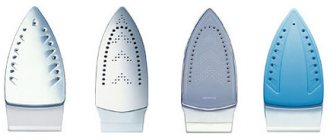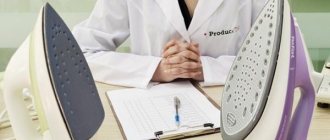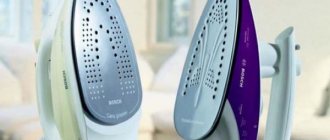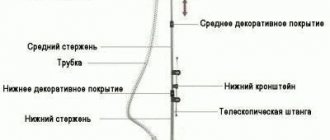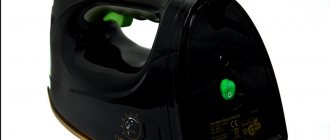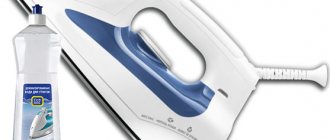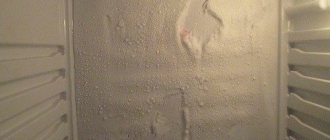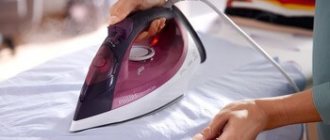There are almost 900 iron models on the market. And each one has an iron sole. Among such a choice, it’s time to get confused. Moreover, each type of sole has its undoubted advantages and disadvantages.
Text: Natalya Konopleva, Daria Alexandrova
Undoubtedly, it is easier, without hesitation, to take an iron with a titanium or enamel sole. Such a high-tech miracle will cost 2500 - 3000 rubles.
If you choose: aluminum or stainless steel, then you need to build on your requirements. The most important thing for you is durability - buy an iron with a stainless steel sole; if you are interested in ease and speed of heating, then give preference to a product with an aluminum sole.
If you are an unpretentious person, you treat technology very carefully, and ironing thin silk blouses or wool items is a rarity in your home, then, of course, you can prefer an inexpensive model with a sole made of ordinary polished steel (aluminum without additional coating is practically no longer found today ).
If the housewife most of all values comfort in any household work, and her things require special care, then, most likely, she will give preference to soles with titanium, nickel-plated or glass-ceramic coating. Such models have a number of advantages, while they have practically no disadvantages. And the price is quite affordable and justified.
People who are especially careful with things and at the same time prefer only high-quality equipment can afford to purchase an iron with Teflon coating or a ceramic outer layer.
Stainless steel or lightweight aluminum?
Dozens of specialists are working to develop unique alloys that would make the sole as resistant to damage as possible, and at the same time it would glide over any fabric with ease.
Actually, the sole itself is made of only two materials - aluminum and stainless steel. The first electric irons were equipped with an aluminum soleplate. Of course, after the heavy cast iron alloy, this seemed like a technological breakthrough. Aluminum is an excellent heat conductor; it heats up instantly and cools down just as quickly.
Plus, it is a very light metal and inexpensive. Thanks to these qualities, the aluminum sole heats up very quickly and glides perfectly over the fabric.
However, it also has its drawbacks. For example, soft metal is easily scratched by buttons and zippers; over time, microcracks become clogged with lint, dust particles and lime, and as a result, the sole quickly loses its high sliding performance.
In addition, such a sole leaves unsightly shiny areas on thin fabrics or fabrics with pile, so many products have to be ironed from the inside out.
The importance of the sole in the design of the iron
No matter how innovative and technologically advanced the iron is, the main element in this household electrical appliance is still the soleplate. In fact, it is with its help that high-quality gliding occurs over tissues of various structures and densities. The soleplate for the iron is responsible for the efficiency of ironing, the pressure on the material, the direction of movement, the quality of ironing small parts and delicate fabrics. After all, there is nothing more offensive than annoying stains left by an iron on your favorite clothes.
To prevent a heated electrical appliance from leaving marks and burning holes in things dear to your heart, you need to find out what its base is made of and what coating is applied.
Now there are more than twenty types of coatings, the main function of which is flawless and safe ironing. So what should the ideal sole be?
- The sliding of the unit over various tissues, regardless of structure, should be smooth and soft.
- There should be no cracks or damage; strength and wear resistance are important.
- It is necessary that the base heats up quickly and evenly.
- Should handle delicate fabrics without damaging them.
Sandwiches for iron holders
And as a result, irons with the same aluminum sole, but with an additional outer coating, saw the light of day. For example, ceramics (Siemens, Bosch, Philips, Bork).
It glides easily over any fabric, leaves no marks on it, but is very sensitive even to any blows: fragile in its structure, ceramics crack easily.
Tefal developed glass-ceramic and metal-ceramic soles, which are successfully used to this day. This alloy turned out to be durable, reliable and easy to iron. But over time, soot may form on such a sole, and it will lose its advantages.
Companies Bork, Atlanta, Kenwood, Unit use Teflon coating on the soles of irons (thin spraying on an aluminum base). Nothing sticks to such a sole, but it is scratch-resistant, and the non-stick layer is often partially erased.
And Philips engineers still use aluminum as the main material. The most common types of soles in this company are Careeza (an additional coating, the composition of which is kept secret by manufacturers) and Anodilium (anodized aluminum that has undergone special treatment). Both types of soles are scratch-resistant, durable and have high slip properties.
Advantages and disadvantages of the sole
Irons with Eloxal bases have significant advantages over other models. Some of the main advantages include:
- Ease. Aluminum platforms are particularly durable, but this does not affect their weight in any way. The iron does not cause rapid fatigue during use.
- Durability. The innovative base is particularly resistant to damage and is not subject to scratches or abrasions. You can safely iron items with hard fasteners and decorative elements with an iron.
- Corrosion resistance. Even with frequent use in steaming mode, the household appliance does not become rusty and resists plaque from hard water well.
- Good glide. Models with Eloxal sole type are especially easy to move across fabric and do not require extra effort from the user when ironing.
There are practically no disadvantages to the innovative platform from Braun. The only downside is that the devices are still sensitive to strong impacts and can be damaged if dropped.
Eloxal irons from Brown do not burn when processing synthetic items
The steel character of the “queen” of soles
Aluminum gradually began to lose its position, and stainless steel quickly took the leading place.
It was first used by the Rowenta company to create irons, and this material immediately began to be used by other manufacturers. And for several decades now, stainless steel has been the most popular base for iron soles, and global changes are unlikely to occur in the coming years.
It turned out that stainless steel as a sole for irons has many advantages over other materials.
First of all, it is beneficial both for users and for the manufacturers themselves, if only because it is an inexpensive material.
In addition, steel is extremely strong and reliable. It is virtually resistant to impacts and scratches, heats up easily and cools quickly (slightly longer than aluminum).
Excellent cleaning from possible carbon deposits and textile particles. The only limitation is poor glide compared to ceramic coatings. However, special thorough polishing at the production stage relieves the user of this problem.
Types of soles
Depending on the material of the sole there are:
- ceramic;
- aluminum;
- stainless;
- Teflon;
- composite;
- titanium.
Ceramic sole
Only a few manufacturers make ceramic soles for their irons.
Positive properties:
- glides easily;
- does not wrinkle the fabric;
- does not catch things;
- easy to clean.
Negative properties:
- fragility of the material;
- If a scratch (chip) appears on the sole, ironing will be more difficult.
Due to its fragility, small scratches often form on the sole. Even such a minor defect causes the housewife a lot of inconvenience when ironing. The only way out is to be very vigilant and careful.
There are a large number of irons with ceramic soles on sale. There are no ceramic soles without impurities. They must include one of the materials: durable steel, durable aluminum or an alloy of materials.
When purchasing, choose models from Tefal, Vitek, Bosch.
Ceramic-metal sole
Metal-ceramics are increasingly being used in production. The demand for irons with this coating is great. The coating behaves well when ironed. The surface is cleaned with a regular sponge. Metal ceramics stand out significantly in terms of design.
Heating of the surface in metal-ceramic irons occurs using spirals, which provide uniform heating. Sometimes manufacturers use heating elements. Despite its positive aspects, metal ceramics are easily subject to deformation and mechanical damage.
Companies producing household appliances tried to combat these shortcomings. The result of the struggle was the release of iron models with transverse stripes on the sole. They were made using steel casting. These devices did an excellent job with over-dried laundry and easily resisted damage. The tip of the iron became as hot as possible. Therefore, the sole made it possible to conscientiously iron all hard-to-reach places.
If you want to purchase a cermet iron, it is better to buy a device from Tefal. The company has been using this coating in its irons for a long time and has managed to correct most of the errors in the production of new products.
So, ceramics or another material, it's up to you.
Aluminum sole
Aluminum is the very first material that was used in the production of irons.
Positive traits:
- ease;
- high thermal conductivity;
- fast heating;
- maneuverability;
- reasonable cost;
- fast cooling.
Negative qualities:
- easily deformed;
- scratches quickly;
- leaves a shine on the fabric.
Ironing items with irons with aluminum soles should only be done through gauze.
This iron sole material has significant disadvantages. However, it continues to be used in production due to its availability and low cost.
Manufacturers know well which sole it is better to purchase a device with. They are constantly trying to improve the soleplate of the iron by covering it with various additional materials.
In order for the aluminum sole of the iron to have the qualities of a ceramic product, it is coated with ceramics. As a result, such a double sole glides well and easily irons synthetics. The device leaves no marks and remains lightweight.
Another way to improve the quality of the sole is to apply an oxide film (anodizing). The sole turns out to be golden in color and lasts longer.
If the question is about buying an aluminum iron, then it is better to choose a device with an anodized sole. Manufacturers such as Philips and Rowenta have proven themselves well.
Stainless sole
Which iron sole is the most popular, you ask? Stainless steel (stainless steel).
Positive properties:
- glides easily and quickly across fabric;
- smoothes perfectly;
- durable;
- resistant to corrosion;
- affordable price.
Negative properties:
- The iron is a bit heavy.
Manufacturers are trying to make stainless steel soles more practical. An element such as chromium helps them well in this. By applying chrome to the soleplate, the iron is given durability and protected from corrosion.
An iron with a stainless sole is the most profitable budget option.
Braun, for example, uses a special sapphire powder. As a result, the soles of the irons have:
- durability;
- super strength;
- very good sliding properties.
This coating was specially developed for irons with stainless soles. Sapphire coating greatly improves the quality of the product. Small wrinkles and difficult folds are smoothed out perfectly.
If a regular stainless steel iron is cheap, then with sapphire coating it immediately becomes more expensive. To understand that the material has been treated for greater durability and improved ironing quality, look for the "Careeza" or "Anodilium" designations.
The widest range of models is in the line with this coating. Choose between Rolsen, Scarlett, Vitek, Panasonic and many more.
Teflon sole
Teflon coating is similar in characteristics and quality to aluminum. Therefore, the answer to our question: “Which iron soleplate is better?” not found yet.
Positive properties:
- ease of sliding;
- good ironing of the material;
- non-stick coating;
Negative properties:
- the surface is easily scratched.
Due to the fact that the surface is non-stick, the soleplate of the iron is easy to clean.
What other properties distinguish non-stick coating: with such a coating it is impossible to burn and damage the material. We choose Kenwood, Bork, Atlanta and Unit.
Composite outsole
Manufacturers were prompted to create this sole by the fragility of the surface of its predecessors. It has been observed that composite materials are stronger than ceramics and aluminum. In addition, they perfectly withstand damage from metal objects.
Positive properties:
- fast sliding;
- high strength;
- wear resistance.
The material is so durable that it can easily withstand damage from metal locks and buttons.
You can look at models from the famous Philips brand.
Titanium sole
Which iron sole coating is better and more expensive? Of course, titanium. There are several models of irons with this coating on the market. The fact is that titanium is an expensive material. If you don’t look at the price, this iron will delight you with its excellent quality and durability for a long time. The cost of the device is its only drawback.
Positive properties:
- brilliant glide;
- good thermal conductivity;
- impact resistance;
- durability.
Models with similar soles are produced by Philips, Panasonic, Bork.
Other operations
Apart from ironing, what kind of sole should it have or what should it be able to do? Several other operations are used in everyday life, such as ironing, ironing, steaming and ironing. If your model can do any of the above, then you are very lucky.
In addition to the listed models, you can find irons with replaceable soles on the market. The type of sole is selected depending on the type of material. This universal option will last longer than others and will be convenient to use.
Ceramic coating, like a layer of chocolate on a Snickers
To further improve the functionality of the sole, many manufacturers have also begun to provide additional coatings.
For example, Panasonic uses titanium sole coating in the production of irons. This is a very durable material. Unlike ceramics, such a sole is protected from chips and cracks, and is ready to serve its owner well for many years. In addition, it has one surprisingly useful property.
If the housewife accidentally got distracted and left a hot iron on the blouse, then the item may be damaged, but the sole will not have to be revived by scraping off the stuck and burnt fibers of the fabric. Simply unplug the iron from the outlet and, after the appliance has completely cooled down, gently wipe the work surface with a cloth.
Enamel, nickel, sapphire - what else?
One of the most successful developments was the sole made of high-quality stainless steel with an enamel coating (Siemens, Bosch, Tefal).
Super strong, perfectly smooth, it glides easily over the fabric without wrinkling even delicate silk, nothing sticks to it, and after years it remains in perfect shape, without losing any of its qualities.
Another successful invention was the nickel-plated work surface (Panasonic). The basis, as before, is stainless steel.
It is known that nickel is a very durable material and is practically not subject to mechanical damage and abrasion. In addition, nickel provides excellent protection against corrosion, is resistant to external influences, and retains a shiny, smooth surface for years, which prevents dirt from sticking and makes cleaning easier.
Well, Braun has been using the well-known and revered Saphir coating for several years now - the latest achievement of specialists in this field. Sapphire is one of the hardest minerals along with diamond, ruby and quartz.
Of course, this does not mean that the iron is coated with sapphire (then its cost would be sky-high), but this stone is used in the soleplate manufacturing technology.
The super-hard coating is not afraid of not only impacts, but even sharp needles and blades. If desired, you can rub it with an iron brush, and the sole will retain its polished surface in its original form. But it is unlikely that the housewife will ever have to do this. Indeed, in addition to strength, sapphire coating also has such qualities as lightness, and nothing sticks to it.
On the question of whether aluminum or stainless steel is better, Bosch and Siemens apparently still have not come to a definite conclusion, and therefore produce models with an aluminum-based sole with a stainless steel coating.
Thus, the sole combines the advantages of both materials, but eliminates the disadvantages of both. At the same time, the cost of the iron as a whole can be kept quite acceptable.
Following Philips, many companies have picked up the trend of giving the soles of their irons beautiful, intriguing names: Careeza (Philips), Eloxal (Braun), Ultragliss, Diffusion (Tefal), etc.
Of course, brand managers can decipher the beautiful words to specialists by telling them in more detail about the composition of the sole. But no one will write you the complete chemical formula of the material - it’s a company secret!
General information about the soleplate of the Saphir iron
You should not judge the appearance of the plate of an electrical appliance by its name. In reality, precious stones are not used in the manufacture of Saphir, and the consonant name is a publicity stunt.
The composition of the sole is classified by the manufacturer. Based on the performance properties of Saphir, experts concluded that the plate contains:
- chromium,
- nickel,
- aluminum,
- zinc.
The technical characteristics of the alloy's strength are similar to those of diamond. It will not be possible to scratch such a surface even on purpose using a needle, knife or kitchen scraper. Thanks to polishing with diamond chips, the surface of the plate is perfectly smooth.
During the research, the developers came to the conclusion: minor changes in the characteristics of Saphir can change after 8 years of daily operation, provided that 400 km of cotton fabric is ironed with the electric device (which is 16 km more than the distance from the Earth to the Moon), and 40 days The device must be exposed to sudden changes in temperature.
When looking for an iron with a unique sole, you need to pay attention to the following models:
- Braun TexStyle 7 TS785STP, saphir iron sole, power 2400 W, steam boost - 210 g/min;
- Braun SI9188BK, saphir 3D Premium BackGlide iron sole - features high power - 2800 W, steam impact force - 230 g/min.
Irons with sapphire surfaces are in great demand. Trying to attract a potential buyer, other manufacturers use words in their names that sound similar to “sapphire,” for example, Russell Hobbs Light & Easy Brights Sapphire iron sole, but the surface of this device is ceramic and has nothing in common with the development of Saphir.
And why do you need this holey sole?
Why do manufacturers provide the iron with a certain number of holes? And why are their locations and sizes different? Does this play any role in ironing efficiency?
Trips to hardware stores yielded nothing. Not one of the sales consultants at specialized stores and not even one of the brand managers of the companies could really explain to us the advantage of one hole distribution system over another.
Why are there exactly twelve holes “here”, and not eleven or thirteen, and why “there” is a hole on the sole with a diameter of exactly three millimeters, and not two and a half, and why exactly this combination is considered by one manufacturer or another to be the most optimal.
Well, we will conduct, as befits a private investigator, an independent study of the problem.
The sole breathes through the holes!
Initially, the soles of steam irons were equipped with only two rows of identical holes, which were located along the sides of the sole. However, leading manufacturers quickly realized that in this case the steam did not sufficiently moisten the fabric.
Firstly, at that time the irons were not as powerful as modern models - the maximum emission of constant steam was no more than 15 g/min.
Secondly, the holes located far from each other could not distribute hot steam over the entire surface of the fabric.
In this case, the correct solution was to increase the number of holes. And some manufacturers added a second row of side holes, others made additional holes on the toe of the sole.
What to look for when choosing a sole
When choosing an iron, you should pay attention not only to the material of the sole, but also to other important design features.
- Trailing edge. The rounded geometry of the back surface makes ironing easier, especially when moving backwards.
- Spout shape. It should be sharp enough to fit between buttons and other similar places.
- Location and number of steam holes. Many holes distributed over the entire surface and soles will facilitate the steaming process.
- Availability of a “platform”. The sole protruding along the perimeter with a thin edge can fit under the stitching of a shirt or button.
